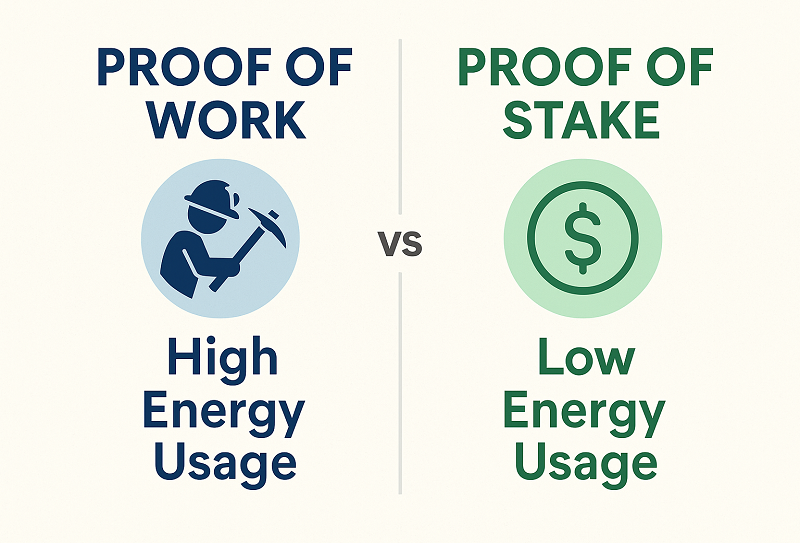Blockchain technology has changed how we think about security, transparency, and decentralization. But there’s one big challenge: energy consumption.
Some older blockchain systems use massive amounts of electricity to validate transactions.
This has raised environmental concerns and pushed the industry to search for energy-efficient blockchain consensus algorithms.
In this article, we’ll explain what these algorithms are, how they work, and why they matter for the future of blockchain.
What is a Blockchain Consensus Algorithm?
A blockchain is a shared digital ledger where no single person controls the network.
To keep it secure and trustworthy, all participants must agree on the state of transactions — this process is called consensus.
A consensus algorithm is the set of rules and methods that blockchain nodes follow to reach this agreement.
Without it, there would be no way to confirm transactions or maintain the blockchain’s integrity.
Two popular traditional methods are:
- Proof of Work (PoW): Miners solve complex puzzles to validate transactions.
- Proof of Stake (PoS): Validators lock up cryptocurrency to secure the network.
The Energy Problem in Blockchain
Proof of Work, while secure, comes with a heavy cost: electricity.
Bitcoin mining alone consumes as much energy as some small countries.
This high energy usage has three main drawbacks:
- Environmental Impact – Increased carbon footprint.
- Cost Barrier – Expensive to run and maintain.
- Scalability Issues – Hard to support more transactions without more energy.
That’s why energy-efficient consensus algorithms are becoming the focus for developers and investors.
What Makes a Consensus Algorithm Energy-Efficient?
A consensus algorithm is considered energy-efficient when it can secure the network with minimal electricity and hardware use.
Here are the key factors:
- Lower computational demand: Less processing power means lower energy consumption.
- Reduced hardware strain: Nodes don’t need expensive, power-hungry machines.
- Faster validation: Less time spent verifying transactions means less energy used.
Some well-known energy-efficient approaches include:
- Proof of Stake (PoS)
- Delegated Proof of Stake (DPoS)
- Proof of Authority (PoA)
Popular Energy-Efficient Consensus Algorithms
1. Proof of Stake (PoS)
In PoS, validators are chosen based on the amount of cryptocurrency they “stake” rather than solving puzzles.
This eliminates the need for massive computing power.
- Pros: Energy-saving, faster transactions, more scalable.
- Cons: Risk of wealth centralization.
2. Delegated Proof of Stake (DPoS)
A variation of PoS where token holders vote for a small group of trusted validators.
These validators confirm transactions on behalf of the network.
- Pros: Very fast, efficient, and democratic in selection.
- Cons: Can be less decentralized.
3. Proof of Authority (PoA)
In PoA, trusted and verified validators run the network.
It’s common in private or consortium blockchains.
- Pros: Extremely efficient, low-cost, and high-speed.
- Cons: Requires trust in validators, less open than PoW or PoS.
4. Proof of History (PoH)
Used by Solana, PoH adds a verifiable timestamp to transactions, allowing nodes to agree on the order without heavy computation.
- Pros: Ultra-fast and efficient.
- Cons: Relatively new and still evolving.
Comparison Table – Energy Usage
| Algorithm | Energy Use | Decentralization | Speed |
|---|---|---|---|
| PoW | Very High | High | Slow |
| PoS | Low | Medium-High | Fast |
| DPoS | Low | Medium | Very Fast |
| PoA | Very Low | Low | Very Fast |
| PoH | Low | Medium | Ultra Fast |
Real-World Projects Using Energy-Efficient Algorithms
- Ethereum – Moved from PoW to PoS in “The Merge” (2022), reducing energy use by over 99%.
- Solana – Uses PoH for high-speed, low-energy transactions.
- Cardano – Built on the Ouroboros PoS protocol for eco-friendly validation.
Benefits Beyond Energy Savings
Energy-efficient consensus algorithms bring more than just lower electricity bills:
- Lower operational costs – Ideal for startups and smaller networks.
- Faster transaction speeds – Better user experience and scalability.
- Easier adoption – Businesses and governments are more open to sustainable tech.
Challenges and Limitations
While they save energy, these algorithms face challenges:
- Security debates – PoW is still considered the most battle-tested.
- Centralization risks – Some methods rely on fewer validators.
- Regulatory hurdles – Governments are still figuring out blockchain laws.
Future of Energy-Efficient Blockchain
With global focus on sustainability, green blockchain solutions will likely become the standard.
Emerging technologies, hybrid consensus models, and AI-driven validation could make networks even more efficient.
Blockchain’s future depends on balancing security, decentralization, and sustainability — and energy-efficient consensus algorithms are the key to that balance.
Conclusion
Energy-efficient blockchain consensus algorithms are not just a technical upgrade — they’re a necessity for blockchain’s long-term survival.
From Proof of Stake to Proof of History, these methods reduce power usage, cut costs, and speed up transactions without sacrificing too much security.
If blockchain is to grow globally, it must be green, scalable, and inclusive.
And that’s exactly what energy-efficient blockchain consensus algorithms aim to achieve.
FAQs
1. What is the most energy-efficient blockchain algorithm?
Proof of Stake (PoS) and its variants are currently considered the most energy-efficient.
2. How does Proof of Stake save energy?
It replaces computational puzzles with token staking, removing the need for energy-hungry mining.
3. Which blockchains are eco-friendly?
Ethereum (after The Merge), Cardano, and Solana are popular eco-friendly options.
4. Is blockchain sustainable in the future?
Yes, if it adopts energy-efficient consensus methods and renewable energy sources.
If You want to know more information , You can visit our Website urbanmatter.cloud
